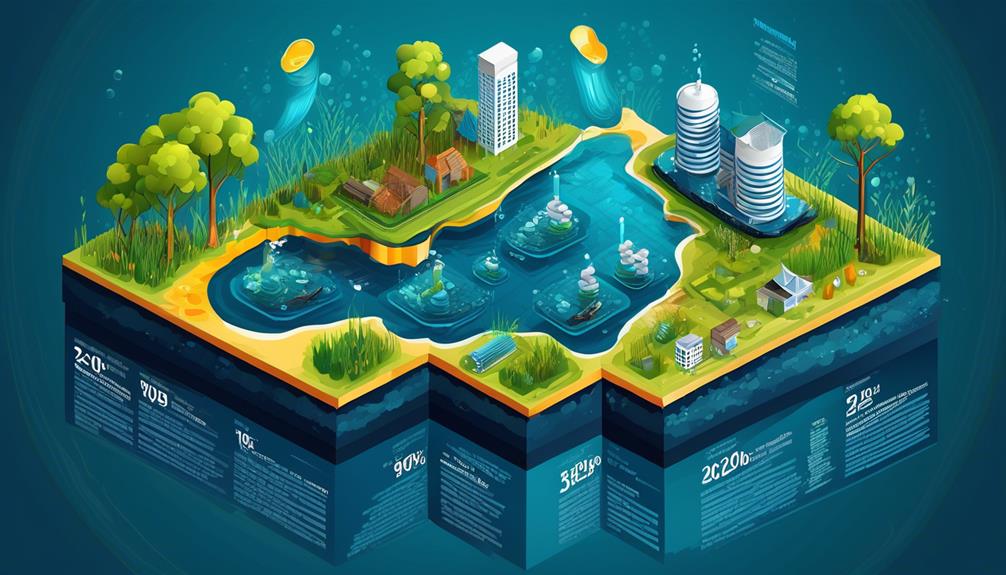Water pollution statistics paint a stark picture of the state of our waterways. The impact of water pollution is far-reaching and affects not only the environment but also human health.
As I delve into the latest statistics, you'll see the sobering reality of how water pollution is affecting our lives and the urgent need for action to address this critical issue.
Key Takeaways
- Water pollution causes more deaths annually than war and all other forms of violence combined.
- Less than 1 percent of the Earth's freshwater is accessible to us.
- Global demand for freshwater is expected to increase by one-third by 2050.
- Agricultural pollution is the leading cause of water degradation worldwide.
Global Water Pollution Overview
Global water pollution poses a significant threat to human health and the environment due to the widespread contamination of freshwater sources. This is a critical issue because water pollution causes more deaths annually than war and all other forms of violence combined.
It's alarming to note that less than 1 percent of the Earth's freshwater is accessible to us, and the global demand for freshwater is expected to increase by one-third by 2050. The impacts of water pollution are far-reaching, with algal blooms reducing oxygen levels and marine debris harming over 200 species.
What's concerning is that over 80% of industrial and municipal wastewater is discharged into water bodies without treatment, exacerbating the problem. These statistics paint a grim picture of the global water pollution crisis, highlighting the urgent need for action to address this issue.
It's imperative that we work towards sustainable and responsible management of freshwater resources to safeguard human health and the environment for future generations.
Sources of Water Contamination

As I look into the sources of water contamination, industrial waste and agricultural runoff emerge as significant contributors. The release of toxic chemicals from industrial activities and the use of pesticides and fertilizers in agriculture pose serious threats to aquatic ecosystems.
It's crucial to address these sources in order to effectively combat water pollution.
Industrial Waste
Industrial activities release toxic chemicals and substances into aquatic ecosystems, significantly contributing to water pollution. The discharge of pollutants like arsenic, cadmium, and chromium from industrial sources poses a threat to water quality. Additionally, agriculture contributes to water pollution through the release of pesticides, fertilizers, and organic waste into water bodies. Natural factors, such as weathering and manufacturing, can also cause water pollution, impacting the quality of water resources. Furthermore, insufficient water supply and sewage treatment facilities play a significant role in contributing to water pollution, highlighting the various sources of contamination in water.
| Industrial Waste Pollutants | Effects on Water Quality | Implications |
|---|---|---|
| Arsenic | Contamination of drinking water | Adverse health effects |
| Cadmium | Bioaccumulation in aquatic life | Ecosystem disruption |
| Chromium | Toxic to aquatic organisms | Long-term environmental impact |
Agricultural Runoff
Agricultural runoff, stemming from the excessive use of fertilizers and pesticides, poses a significant threat to water quality and ecosystem health. It's crucial to understand the impact of agricultural practices on water contamination.
Here are some important facts to consider:
- Agricultural runoff is a major source of water contamination, caused by fertilizers, pesticides, and animal waste washing into waterways.
- Excess nitrogen and phosphorus from agriculture pose a threat to water quality, leading to harmful algal blooms.
- Farming, the biggest consumer of global freshwater, utilizes about 70% of the earth's surface water supplies, contributing to water degradation.
- Agricultural pollution is the leading cause of water degradation worldwide, impacting the quality of water resources.
These facts highlight the pressing need for improved management practices in the agricultural sector to mitigate water pollution.
Impact on Human Health
Water pollution has a direct impact on human health, leading to an increased risk of diseases like diarrhea and contributing to the spread of infectious and parasitic diseases.
Contaminated water poses significant health risks, especially for low-income communities, and can result in a higher incidence of illness and health issues.
The presence of waterborne pathogens and chemical pollutants necessitates government intervention and regulations to mitigate these adverse effects and improve overall water quality.
Health Risks
Exposure to contaminated water sources can pose serious health risks, leading to a range of illnesses and diseases in humans. The impact of water pollution on human health includes:
- 1.8 million annual deaths and 1 billion people affected by water pollution, disproportionately impacting low-income communities.
- Waterborne pathogens and chemical pollutants causing various health issues and illnesses.
- Transmission of diseases like cholera, diarrhea, and typhoid due to inadequate water and sanitation services, particularly in healthcare facilities.
- Over 1 million deaths each year from diarrheal diseases and over 251.4 million people affected by diseases due to exposure to contaminated water sources.
These statistics highlight the severity of health risks associated with water pollution, emphasizing the urgent need for effective solutions to ensure access to clean and safe water for all.
Disease Transmission
Every year, water pollution contributes to the transmission of numerous diseases, leading to a significant burden on public health systems and communities worldwide. Unsafe water is responsible for approximately 829,000 deaths annually from diarrhea, with children under five years of age accounting for nearly 300,000 of those deaths.
Drinking municipal water directly increases the risk of diseases like diarrhea, highlighting the impact of water pollution on human health. Poor water quality is also linked to an increased incidence of infectious and parasitic diseases, emphasizing the need to address water pollution for public health.
It's crucial for governments to implement policies, regulations, and intervention measures to reduce the impact of water pollution on human health. By addressing water pollution, we can mitigate the transmission of these diseases and improve public health outcomes globally.
Environmental Consequences

Algal blooms, marine debris, and disruption of aquatic ecosystems are some of the environmental consequences caused by water pollution. These consequences have far-reaching impacts on both the environment and human society.
- Algal blooms, fueled by excessive nutrients from pollutants, can lead to oxygen depletion in water bodies, harming fish and other aquatic life.
- Marine debris, such as plastic waste, not only pollutes the water but also poses a threat to marine animals through ingestion or entanglement.
- Disruption of aquatic ecosystems can result in the loss of biodiversity and the degradation of essential habitats, affecting the balance of entire ecosystems.
- Contaminants in water sources can also find their way into the food chain, potentially impacting human health through the consumption of contaminated fish and water.
These environmental consequences highlight the urgent need for effective water pollution control measures to safeguard both the well-being of ecosystems and the health of human populations.
Regional Water Pollution Statistics

In light of the environmental consequences of water pollution, it's crucial to examine the specific regional water pollution statistics to understand the localized impact on ecosystems and human populations. The statistics reveal alarming trends.
In China, 40% of bodies of water are polluted, affecting over 700 million people who rely on contaminated water sources. Moreover, over 80% of wastewater globally contaminates groundwater and other parts of the Earth, significantly contributing to water pollution.
The projections for the future are equally concerning, with an estimated 47% of the world's population expected to struggle to find sufficient drinking water by 2050 due to the scarcity of clean water caused by untreated wastewater dumping. Additionally, the immense volume of plastics being dumped into the ocean—14 billion pounds annually—is causing severe harm to marine life and ecosystems.
These regional statistics underscore the urgent need for governments worldwide to implement stringent policies and regulations to prevent water pollution, reduce its impact on human health, and invest in water supply and treatment facilities to effectively manage water quality.
Trends in Water Pollution

Examining the latest data on water pollution reveals concerning trends that demand immediate attention and action. The following trends are particularly alarming:
- Water pollution causes more deaths annually than war and all other forms of violence combined.
- Less than 1 percent of the Earth's freshwater is accessible to us, and the global demand for freshwater is expected to increase by one-third by 2050.
- Agriculture is the biggest consumer of global freshwater resources and a leading cause of water degradation.
- Excess nitrogen and phosphorus from agriculture threaten water quality and can lead to harmful algal blooms.
These trends underscore the urgent need for comprehensive measures to address water pollution. The disproportionate impact on low-income communities and the staggering number of deaths and illnesses linked to water pollution highlight the severity of the issue.
It's crucial to prioritize sustainable water management practices and implement policies that regulate agricultural runoff to safeguard water quality for current and future generations. Addressing these trends is essential to ensure access to safe and clean water for all.
Solutions and Prevention Efforts

Sustainable water management practices and strict regulations are essential for effectively addressing water pollution and preventing its detrimental effects on communities and the environment. Implementing proper wastewater treatment for industrial activities is crucial in preventing water pollution.
By encouraging sustainable agricultural practices that focus on reducing the use of pesticides and fertilizers, we can also significantly contribute to preventing water pollution. Protecting natural water sources from contamination through strict regulations and enforcement is an effective solution.
Investing in and enhancing water treatment facilities and infrastructure is crucial for preventing water pollution. Additionally, promoting public awareness and education about water pollution and its prevention can lead to proactive measures by individuals and communities.
These efforts, combined with technological advancements and research in water treatment, are key to preventing and mitigating water pollution. By working together and prioritizing these solutions, we can ensure a healthier and sustainable water environment for future generations.
Frequently Asked Questions
How Does Water Pollution Impact Marine Life and Ecosystems?
Water pollution significantly impacts marine life and ecosystems. Harmful substances decrease water quality, making it toxic for both humans and the environment. Algal blooms, chemical accumulation, and debris harm organisms, disrupting entire ecosystems and threatening human health.
What Are the Long-Term Effects of Water Pollution on Drinking Water Quality?
Long-term exposure to contaminated drinking water can cause chronic health issues such as cancer, organ damage, and reproductive problems. The accumulation of harmful chemicals and pathogens poses serious health risks over time.
Are There Any Specific Industries or Activities That Contribute the Most to Water Contamination?
Certain industries, such as agriculture and manufacturing, contribute the most to water contamination. High use of fertilizers, pesticides, and improper waste disposal are significant factors. Comprehensive pollution prevention measures are needed to address these issues.
How Do Different Regions Compare in Terms of Water Pollution Levels and Trends?
Different regions experience varying water pollution levels due to industrialization, agricultural practices, and water management policies. This influences contamination trends. Industrialized areas discharge toxic substances, while agricultural regions face pollution from pesticides and organic waste.
What Are Some Innovative Solutions Being Implemented to Prevent Water Pollution?
I'm seeing innovative solutions to prevent water pollution. Green infrastructure, sustainable agriculture practices, pollution control devices, advanced wastewater treatment, and pollution monitoring systems are being implemented, utilizing natural systems and advanced technologies to protect water quality.
Conclusion
As I reflect on the water pollution statistics, I can't help but imagine a world where crystal-clear streams and pristine lakes are the norm.
It's clear that urgent action is needed to protect our water resources.
Let's work together to ensure that future generations can enjoy the beauty of clean, unpolluted water.
The time to act is now, before it's too late.










